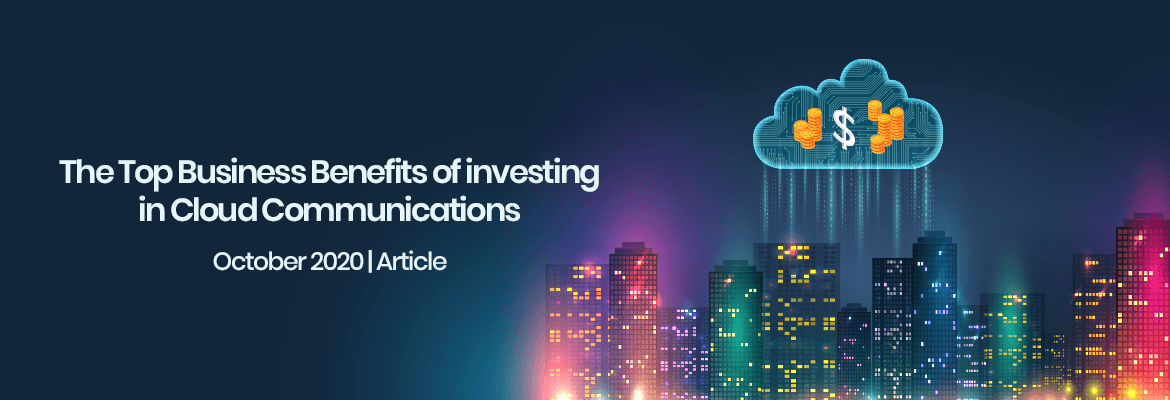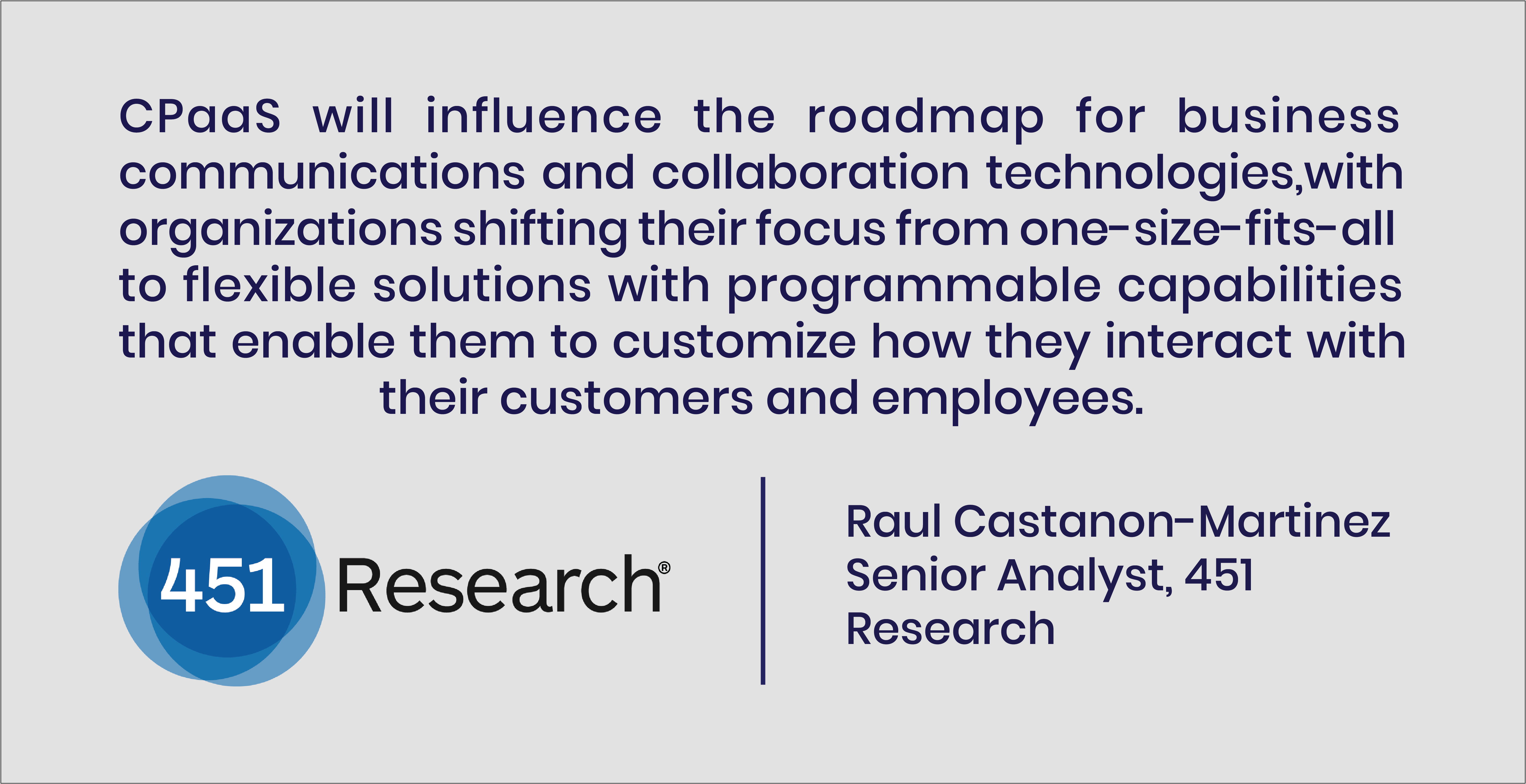

Global digitisation at scale means a constant array of digital communication touchpoints between organizations, vendors, employees and customers. To do this right, the vision and the approach of organizations have to be adequately integrated with real-time communication streams in the form of voice telephony, video conferencing and text messaging with non-real-time types like email, voicemail and fax (yeah, fax). Since the phenomenon is new(ish) and complex for most IT shops, many now look at CPaaS (Communications Platform as a Service) providers for assistance. The driving value behind CPaaS comes from its ability to strengthen business processes like never before. CPaaS has the power to transform the entire communication stack, improve internal technology processes, external communication and more. The whole business can flow more seamlessly without the constant input of human workers. The platform packages modalities of individual offerings (voice, email, chat, video storage and collaboration applications) that help with team alignment and flexibility for better workstyles and customer preferences and offers them with the flexibility and the security of the cloud. Expected to be an $11 billion market by 2022 (IDC), CPaaS bridges the communications gap between an organization and their employees and customers to foster growth and expansion. Some of the other benefits are:

Convenience on the go
Organizations looking for flexible ways to take their tech stack to the next level look towards CPaaS solutions for convenience and cost savings. CPaaS assists various forms of digital transformation, including the ability to use APIs (Application Programming Interface) and SDKs (Software Development Kit) to embed virtual assistants and artificial intelligence into communications. This allows for ease in deployment. As team collaboration tools become an increasingly crucial element of the business landscape, organizations are turning to CPaaS as a way of adding cloud PBX and business phone solutions to chat apps. Access to CRM, data, and collaboration tools are available on the go and independent of location too. This benefits their employees as well as customers. Avaya, a CPaaS provider, assisted a municipality in the US for the creation of an automated self-service application to aid citizens in paying bills and property taxes easily. City officials were able to write an application layer specifying shared communications protocols and invoke data lookup for self-service interaction by embedding APIs for capabilities like speech recognition, recording, and voice transcription into their Avaya-based voice, text and Web applications.
Reduced Costs
 Cost is the primary reason behind 47% of IT professionals migrating communication technologies to the cloud, according to a 2019 report by Opsramp. Cloud enabled voice, video and text communications replace conventional business telephone equipment such as PBXs. The CIO of Avery Dennison, a global material science and manufacturing company, revealed that they saved up to 40% in communication costs after moving to cloud-based virtual phone systems. That’s significant. Bandwidth, an API platform provider, found that working directly with a CPaaS provider can save between 30% and 60% of communication investments. This benefits those that upgrade tech stacks to adopt the benefits of CPaaS by purchasing a flexible pay-as-you-go solution based on data usage. This option, considered by many can establishing voice and messaging presence in remote/developing markets through reduced inbound and outbound calling costs as they no longer have to worry about pricy on-premise tools. This reduces CapEX costs as a potential switch to a model that focuses on reliable and easy-to-manage OpEX expenditure instead can be really beneficial. Frost and Sullivan’s Frost Radar suggests experiments with CPaaS solutions as means to unlock new benefits with an OpEx cost management strategy, instead of incurring CapEx expenses.
Cost is the primary reason behind 47% of IT professionals migrating communication technologies to the cloud, according to a 2019 report by Opsramp. Cloud enabled voice, video and text communications replace conventional business telephone equipment such as PBXs. The CIO of Avery Dennison, a global material science and manufacturing company, revealed that they saved up to 40% in communication costs after moving to cloud-based virtual phone systems. That’s significant. Bandwidth, an API platform provider, found that working directly with a CPaaS provider can save between 30% and 60% of communication investments. This benefits those that upgrade tech stacks to adopt the benefits of CPaaS by purchasing a flexible pay-as-you-go solution based on data usage. This option, considered by many can establishing voice and messaging presence in remote/developing markets through reduced inbound and outbound calling costs as they no longer have to worry about pricy on-premise tools. This reduces CapEX costs as a potential switch to a model that focuses on reliable and easy-to-manage OpEX expenditure instead can be really beneficial. Frost and Sullivan’s Frost Radar suggests experiments with CPaaS solutions as means to unlock new benefits with an OpEx cost management strategy, instead of incurring CapEx expenses.
Growth and Profitability
An increasing number of tech-savvy organizations and industry leaders are recognizing the many benefits of cloud communications and incorporating it within their operational processes. A 2019 report from Dell revealed that organizations that invest in big data, cloud, mobility, and security enjoy up to 53% faster revenue growth than their competitors. More importantly, they are using this technology to more efficiently run their organizations, better serve their customers, and dramatically increase their overall profit margins. With information stored in the cloud, the implementation of tracking mechanisms and building customized reports to analyze information can be managed smoothly. From those insights, organizations can increase efficiency and build action plans to meet organizational goals. For example, the beverage company Sunny Delight was able to increase profits by about $2 million a year and cut $195,000 in staffing costs through cloud-based analytics. Moreover, organizations with communications on the cloud can set up new contact centers and environments, as well as tapping into unique new features. CPaaS offers a better way to unlock new functionality without an organization having to rip and replace their communication stack. For instance, integrating omnichannel messaging through a CPaaS provider can help an organization offer personalization to increase profits.
Better customer and employee experience
Intelligent employee collaboration tools that enhance teamwork result in faster response times and increased productivity that help provide a better experience for the customer. A 2020 PTC survey concluded that operational efficiency and the ability to meet enhanced customer experience are by-products of the organization’s digital transformation journey. Covid-19 has changed the way organizations carry their digital transformations, such that having a remote set up for employees and delivering omnichannel capabilities for customers lie at the heart of their communications landscape now more than ever. Customers want continuity in their conversations and CPaaS provides integration between channels, so that agents can interact with customers in a channel-agnostic manner that is fully interconnected. Avaya cloud office brings together calling, messaging, video conferencing, file sharing and collaboration no matter where employees are or what types of devices they’re using. With real-time notifications, easy to access customer data and the ability to measure each customer interaction, organizations can better refine the user experience for higher levels of customer satisfaction. With CPaaS, new elements can be added to an organization’s communication stack whenever they learn something new about their customer’s needs, such as implementing an SMS API to automatically remind clients of upcoming appointments or chatbots and WhatsApp Business APIs for swiftly answering basic queries.
Staying connected in a unified environment
Disjointed communications tools are often a cause of trouble for employees and unified communications take care of that. Research done by No Jitter found that 81% of workers use disparate solutions for conferencing, 83% use different tools for video conferencing, while 88% jump between apps for messaging. What cloud-based communications (UCaaS) tools offer is the ability to utilize valuable solutions such as web conferencing, mobile and desktop apps, and a wide assortment of endpoints, to ensure connectivity of the workforce, in any location using laptops, desk phones, cell phones and even tablets. All the employees need is an internet connection, and all the office functionality they need can be available to them at any given time. With the ability to work on various devices from various locations, organizations can expect to see higher accessibility and productivity through a unified environment. The unified communications and collaboration markets are already expected to grow at around 8% CAGR between 2020 and 2026, validating the many benefits they bring to an organization and how customers are serviced.
Stronger when you integrate
Jacques Der Ohanian of ALE believes, “In a world where people actively research businesses before connecting with them online, CPaaS is essential for driving better discussions with customers.” From chatbot integrations to delivery status notifications sent to a smartphone, CPaaS makes a customer’s relationship stronger with an organization. Organizations have benefited greatly from its ability to combine all of their cloud applications as well as on-premise systems. Gartner reports that there are 14.2 billion connected “things” in use in 2019 and anticipates that there will be 25 billion connected things by 2025. This level of integration opens up huge benefits for the cloud comms space and how it interacts with other areas of tech. This practice gives organizations comprehensive access and visibility into their data, as well as improved functional connectivity. Many organizations recognize the need to integrate with existing platforms such as CRM, operational programs, and billing, etc. With changing work patterns, shifting technologies, and continual customer demands — there is a growing need for an agile solution that can easily adapt to ongoing demands. CPaaS offerings provide just that. Not only can an organization easily deploy a remote workforce through apps and virtual security programs, but can also add new services for its customers, and stay up to date with the latest technology by simply keeping its software updated.
Faster Scalability
User changes, employee changes, on-boarding demands — it’s all made simple through cloud communications. Applications are always reachable with the easy addition of capacity when required, resulting in unlimited scalability. With cloud telephony, an organization can make on-demand changes to a system easily unlike traditional telephone systems. Adding a phone line simply requires easy changes within an administration portal and plugging in a VoIP-compatible handset. Organizations can pay for the usage leveraging the standard subscription model, offering a cost-based model of pay over time. With minimal to no capital infrastructure costs, these “pay-as-you-go subscriptions”, allow an organization’s TCO (total cost of ownership) to be more stable and predictable as well. Moreover, cloud phone systems can easily be scaled to new business locations or remote workers. With UCaaS solutions, organizations can scale their cloud capacity up or down via remote servers or make adjustments to their subscriptions.
Mobility and accessibility rhyme
77% of remote workers report greater productivity while working from home and cloud communications serve as their primary enablers. Research by Gartner reveals cloud hosting is becoming increasingly popular among businesses as they can reap the benefits of both cloud-based communications and their favorite applications while working remotely. As long as employees have access to the cloud, they can use a laptop, tablet, or mobile device to communicate with customers or colleagues. Mobility features make business communications fully available to employees, regardless of whether they’re working in the office, in a conference room, traveling, or working remotely. During the sudden onset of COVID-19 and the urgency to mobilize a virtual workforce, cloud communications and collaboration solutions became attractive and apt resources for organizations looking to ensure business continuity remains strong. A survey of 500 enterprise decision makers for the 2020 State of Disruption Report found that customer interest in UCaaS (Unified Communications as a Service) spiked 86% during the pandemic as organizations across industries adopted cloud communications.
Security and disaster recovery meet high standards
The physical infrastructure the Cloud is typically built on high security and resilience standards. Data center operators depend on guaranteeing high availability to customers, and as a result, protect their assets with fully redundant architecture, high levels of physical security, and 24/7 cyber threat monitoring. Implementing multi-factor authentication and limiting access control can help customers have faith in the organization’s security measures. Moreover, some organizations may worry about having the inability to gain full visibility when there’s disruption or failure of their outsourced communications infrastructure. Under the cloud, there is more visibility to the performance and they are more prepared to combat local outages or large-scale natural disasters. Cloud service providers establish redundant networks in order to meet uptime SLAs, avoid service interruption and keep their customers online as much as they can. Even though mobile carriers may face some downtime during disasters, they can be quick to restore service to affected areas. For example, during California’s wildfires in 2017, AT&T and Verizon reported their services experienced 99% uptime that kept the lines of communication going.
Reap the benefits of your Communications investment; the TransformX way
The TransformX approach enables organizations in rethinking customer experience through innovative and disruptive methods of communication. Our signature Cloud Communications offering helps clients carefully select new CPaaS solutions (or replace existing ones) as a result of a deep study of organizational, functional, and technical dynamics. A comprehensive review of the merits and demerits of the existing CPaaS solution(s) is also offered along with CPaaS program oversight initiatives. We look forward to assisting you in your digital and customer transformation journey by combining elements of the above mentioned Cloud Communications sub offerings — New CpaaS Acquisition, Existing CPaaS Review, and CPaaS Program Oversight. Together we can continue evolving and improving upon our organizational practices and help you make the most of your investment; connect with us now!
Global digitisation at scale means a constant array of digital communication touchpoints between organizations, vendors, employees and customers. To do this right, the vision and the approach of organizations have to be adequately integrated with real-time communication streams in the form of voice telephony, video conferencing and text messaging with non-real-time types like email, voicemail and fax (yeah, fax). Since the phenomenon is new(ish) and complex for most IT shops, many now look at CPaaS (Communications Platform as a Service) providers for assistance. The driving value behind CPaaS comes from its ability to strengthen business processes like never before. CPaaS has the power to transform the entire communication stack, improve internal technology processes, external communication and more. The whole business can flow more seamlessly without the constant input of human workers. The platform packages modalities of individual offerings (voice, email, chat, video storage and collaboration applications) that help with team alignment and flexibility for better workstyles and customer preferences and offers them with the flexibility and the security of the cloud. Expected to be an $11 billion market by 2022 (IDC), CPaaS bridges the communications gap between an organization and their employees and customers to foster growth and expansion. Some of the other benefits are:

Convenience on the go
Organizations looking for flexible ways to take their tech stack to the next level look towards CPaaS solutions for convenience and cost savings. CPaaS assists various forms of digital transformation, including the ability to use APIs (Application Programming Interface) and SDKs (Software Development Kit) to embed virtual assistants and artificial intelligence into communications. This allows for ease in deployment. As team collaboration tools become an increasingly crucial element of the business landscape, organizations are turning to CPaaS as a way of adding cloud PBX and business phone solutions to chat apps. Access to CRM, data, and collaboration tools are available on the go and independent of location too. This benefits their employees as well as customers. Avaya, a CPaaS provider, assisted a municipality in the US for the creation of an automated self-service application to aid citizens in paying bills and property taxes easily. City officials were able to write an application layer specifying shared communications protocols and invoke data lookup for self-service interaction by embedding APIs for capabilities like speech recognition, recording, and voice transcription into their Avaya-based voice, text and Web applications.
Reduced Costs
 Cost is the primary reason behind 47% of IT professionals migrating communication technologies to the cloud, according to a 2019 report by Opsramp. Cloud enabled voice, video and text communications replace conventional business telephone equipment such as PBXs. The CIO of Avery Dennison, a global material science and manufacturing company, revealed that they saved up to 40% in communication costs after moving to cloud-based virtual phone systems. That’s significant. Bandwidth, an API platform provider, found that working directly with a CPaaS provider can save between 30% and 60% of communication investments. This benefits those that upgrade tech stacks to adopt the benefits of CPaaS by purchasing a flexible pay-as-you-go solution based on data usage. This option, considered by many can establishing voice and messaging presence in remote/developing markets through reduced inbound and outbound calling costs as they no longer have to worry about pricy on-premise tools. This reduces CapEX costs as a potential switch to a model that focuses on reliable and easy-to-manage OpEX expenditure instead can be really beneficial. Frost and Sullivan’s Frost Radar suggests experiments with CPaaS solutions as means to unlock new benefits with an OpEx cost management strategy, instead of incurring CapEx expenses.
Cost is the primary reason behind 47% of IT professionals migrating communication technologies to the cloud, according to a 2019 report by Opsramp. Cloud enabled voice, video and text communications replace conventional business telephone equipment such as PBXs. The CIO of Avery Dennison, a global material science and manufacturing company, revealed that they saved up to 40% in communication costs after moving to cloud-based virtual phone systems. That’s significant. Bandwidth, an API platform provider, found that working directly with a CPaaS provider can save between 30% and 60% of communication investments. This benefits those that upgrade tech stacks to adopt the benefits of CPaaS by purchasing a flexible pay-as-you-go solution based on data usage. This option, considered by many can establishing voice and messaging presence in remote/developing markets through reduced inbound and outbound calling costs as they no longer have to worry about pricy on-premise tools. This reduces CapEX costs as a potential switch to a model that focuses on reliable and easy-to-manage OpEX expenditure instead can be really beneficial. Frost and Sullivan’s Frost Radar suggests experiments with CPaaS solutions as means to unlock new benefits with an OpEx cost management strategy, instead of incurring CapEx expenses.
Growth and Profitability
An increasing number of tech-savvy organizations and industry leaders are recognizing the many benefits of cloud communications and incorporating it within their operational processes. A 2019 report from Dell revealed that organizations that invest in big data, cloud, mobility, and security enjoy up to 53% faster revenue growth than their competitors. More importantly, they are using this technology to more efficiently run their organizations, better serve their customers, and dramatically increase their overall profit margins. With information stored in the cloud, the implementation of tracking mechanisms and building customized reports to analyze information can be managed smoothly. From those insights, organizations can increase efficiency and build action plans to meet organizational goals. For example, the beverage company Sunny Delight was able to increase profits by about $2 million a year and cut $195,000 in staffing costs through cloud-based analytics. Moreover, organizations with communications on the cloud can set up new contact centers and environments, as well as tapping into unique new features. CPaaS offers a better way to unlock new functionality without an organization having to rip and replace their communication stack. For instance, integrating omnichannel messaging through a CPaaS provider can help an organization offer personalization to increase profits.
Better customer and employee experience
Intelligent employee collaboration tools that enhance teamwork result in faster response times and increased productivity that help provide a better experience for the customer. A 2020 PTC survey concluded that operational efficiency and the ability to meet enhanced customer experience are by-products of the organization’s digital transformation journey. Covid-19 has changed the way organizations carry their digital transformations, such that having a remote set up for employees and delivering omnichannel capabilities for customers lie at the heart of their communications landscape now more than ever. Customers want continuity in their conversations and CPaaS provides integration between channels, so that agents can interact with customers in a channel-agnostic manner that is fully interconnected. Avaya cloud office brings together calling, messaging, video conferencing, file sharing and collaboration no matter where employees are or what types of devices they’re using. With real-time notifications, easy to access customer data and the ability to measure each customer interaction, organizations can better refine the user experience for higher levels of customer satisfaction. With CPaaS, new elements can be added to an organization’s communication stack whenever they learn something new about their customer’s needs, such as implementing an SMS API to automatically remind clients of upcoming appointments or chatbots and WhatsApp Business APIs for swiftly answering basic queries.
Staying connected in a unified environment
Disjointed communications tools are often a cause of trouble for employees and unified communications take care of that. Research done by No Jitter found that 81% of workers use disparate solutions for conferencing, 83% use different tools for video conferencing, while 88% jump between apps for messaging. What cloud-based communications (UCaaS) tools offer is the ability to utilize valuable solutions such as web conferencing, mobile and desktop apps, and a wide assortment of endpoints, to ensure connectivity of the workforce, in any location using laptops, desk phones, cell phones and even tablets. All the employees need is an internet connection, and all the office functionality they need can be available to them at any given time. With the ability to work on various devices from various locations, organizations can expect to see higher accessibility and productivity through a unified environment. The unified communications and collaboration markets are already expected to grow at around 8% CAGR between 2020 and 2026, validating the many benefits they bring to an organization and how customers are serviced.
Stronger when you integrate
Jacques Der Ohanian of ALE believes, “In a world where people actively research businesses before connecting with them online, CPaaS is essential for driving better discussions with customers.” From chatbot integrations to delivery status notifications sent to a smartphone, CPaaS makes a customer’s relationship stronger with an organization. Organizations have benefited greatly from its ability to combine all of their cloud applications as well as on-premise systems. Gartner reports that there are 14.2 billion connected “things” in use in 2019 and anticipates that there will be 25 billion connected things by 2025. This level of integration opens up huge benefits for the cloud comms space and how it interacts with other areas of tech. This practice gives organizations comprehensive access and visibility into their data, as well as improved functional connectivity. Many organizations recognize the need to integrate with existing platforms such as CRM, operational programs, and billing, etc. With changing work patterns, shifting technologies, and continual customer demands — there is a growing need for an agile solution that can easily adapt to ongoing demands. CPaaS offerings provide just that. Not only can an organization easily deploy a remote workforce through apps and virtual security programs, but can also add new services for its customers, and stay up to date with the latest technology by simply keeping its software updated.
Faster Scalability
User changes, employee changes, on-boarding demands — it’s all made simple through cloud communications. Applications are always reachable with the easy addition of capacity when required, resulting in unlimited scalability. With cloud telephony, an organization can make on-demand changes to a system easily unlike traditional telephone systems. Adding a phone line simply requires easy changes within an administration portal and plugging in a VoIP-compatible handset. Organizations can pay for the usage leveraging the standard subscription model, offering a cost-based model of pay over time. With minimal to no capital infrastructure costs, these “pay-as-you-go subscriptions”, allow an organization’s TCO (total cost of ownership) to be more stable and predictable as well. Moreover, cloud phone systems can easily be scaled to new business locations or remote workers. With UCaaS solutions, organizations can scale their cloud capacity up or down via remote servers or make adjustments to their subscriptions.
Mobility and accessibility rhyme
77% of remote workers report greater productivity while working from home and cloud communications serve as their primary enablers. Research by Gartner reveals cloud hosting is becoming increasingly popular among businesses as they can reap the benefits of both cloud-based communications and their favorite applications while working remotely. As long as employees have access to the cloud, they can use a laptop, tablet, or mobile device to communicate with customers or colleagues. Mobility features make business communications fully available to employees, regardless of whether they’re working in the office, in a conference room, traveling, or working remotely. During the sudden onset of COVID-19 and the urgency to mobilize a virtual workforce, cloud communications and collaboration solutions became attractive and apt resources for organizations looking to ensure business continuity remains strong. A survey of 500 enterprise decision makers for the 2020 State of Disruption Report found that customer interest in UCaaS (Unified Communications as a Service) spiked 86% during the pandemic as organizations across industries adopted cloud communications.
Security and disaster recovery meet high standards
The physical infrastructure the Cloud is typically built on high security and resilience standards. Data center operators depend on guaranteeing high availability to customers, and as a result, protect their assets with fully redundant architecture, high levels of physical security, and 24/7 cyber threat monitoring. Implementing multi-factor authentication and limiting access control can help customers have faith in the organization’s security measures. Moreover, some organizations may worry about having the inability to gain full visibility when there’s disruption or failure of their outsourced communications infrastructure. Under the cloud, there is more visibility to the performance and they are more prepared to combat local outages or large-scale natural disasters. Cloud service providers establish redundant networks in order to meet uptime SLAs, avoid service interruption and keep their customers online as much as they can. Even though mobile carriers may face some downtime during disasters, they can be quick to restore service to affected areas. For example, during California’s wildfires in 2017, AT&T and Verizon reported their services experienced 99% uptime that kept the lines of communication going.
Reap the benefits of your Communications investment; the TransformX way
The TransformX approach enables organizations in rethinking customer experience through innovative and disruptive methods of communication. Our signature Cloud Communications offering helps clients carefully select new CPaaS solutions (or replace existing ones) as a result of a deep study of organizational, functional, and technical dynamics. A comprehensive review of the merits and demerits of the existing CPaaS solution(s) is also offered along with CPaaS program oversight initiatives. We look forward to assisting you in your digital and customer transformation journey by combining elements of the above mentioned Cloud Communications sub offerings — New CpaaS Acquisition, Existing CPaaS Review, and CPaaS Program Oversight. Together we can continue evolving and improving upon our organizational practices and help you make the most of your investment; connect with us now!




